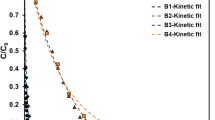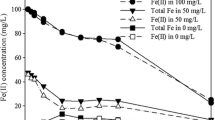Abstract
The reaction of selenate (Se(VI)) with zerovalent iron nanoparticles (nano Fe0) was studied using both conventional batch equilibrium and X-ray spectroscopic techniques. Nano Fe0 has a high uptake capacity for removal of dissolved Se(VI) reaching concentrations as high as 0.10 Se:Fe molar ratio in the solid product mixture. Kinetic studies of the Se(VI) uptake reaction in batch experiments showed an initial reaction rate (0–30 min) of 0.0364 min−1 which was four times greater than conventional Fe0 powder. Analysis of the oxidation state of Se in the solid products by X-ray absorption near edge structure (XANES) spectroscopy showed evidence for the reduction of Se(VI) to insoluble selenide (Se(-II)) species. Structural analysis of the product by extended X-ray absorption fine structure (EXAFS) spectroscopy suggested that Se(-II) was associated with nano Fe0 oxidation products as a poorly ordered iron selenide (FeSe) compound. The fitted first shell Se–Fe interatomic distance of 2.402 (±0.004) Å matched closely with previous studies of the products of Se(IV)-treated Fe(II)-clays and zero-valent iron/iron carbide (Fe/Fe3C). The poorly ordered FeSe product was associated with Fe0 corrosion product phases such as crystalline magnetite (Fe3O4) and Fe(III) oxyhydroxide. The results of this investigation suggest that nano Fe0 is a strong reducing agent capable of efficient reduction of soluble Se oxyanions to insoluble Se(-II).








Similar content being viewed by others
References
Breynaert C, Bruggeman C, Maes A (2008) XANES–EXAFS analysis of Se solid-phase reaction products formed upon contacting Se(IV) with FeS2 and FeS. Environ Sci Technol 42:3595–3601
Charlet L, Scheinost AC, Tournassat C, Greneche JM, Géhin A, Fernandez-Martinez A, Coudert S, Tisserand D, Brendle J (2007) Electron transfer at the mineral/water interface: selenium reduction by ferrous iron sorbed on clay. Geochim Cosmochim Acta 71:5731–5749
Cherin P, Unger P (1972) Refinement of the crystal structure of α-monoclinic Se. Acta Crystallogr B 28:313–317
Choe S, Chang Y-Y, Hwang K-Y, Khim J (2000) Kinetics of reductive denitrification by nanoscale zero-valent iron. Chemosphere 41:1307–1311
Farrell J, Wang J, O’Day P, Conklin M (2001) Electrochemical and spectroscopic study and arsenate removal from water using zerovalent iron media. Environ Sci Technol 35:2026–2032
Géhin A, Greneche J-M, Tournassat C, Brendle J, Rancourt DG, Charlet L (2007) Reversible surface-sorption-induced electron-transfer oxidation of Fe(II) at reactive sites on a synthetic clay mineral. Geochim Cosmochim Acta 71:863–876
Goldberg S (1985) Chemical modeling of anion competition on goethite using the constant capacitance model. Soil Sci Soc Am J 49:851–856
Hsu F-C, Luo J-Y, Yeh K-W, Chen T-K, Huang T-W, Wu PM, Lee Y-C, Huang Y-L, Chu Y-Y, Yan D-C, Wu M-K (2008) Superconductivity in the PbO-type structure a-FeSe. Proc Natl Acad Sci USA 105:14262–14264
Johnson TL, Scherer MM, Tratnyek PG (1996) Kinetics of halogenated organic compound degradation by iron metal. Environ Sci Technol 30:2634–2640
Kanel SR, Manning BA, Choi H (2007) Application of nanotechnology for environmental remediation: synthesis, characterizations and application of surface modified iron nano particles to arsenic remediation. J Nanopart Res 9:725–735
Lien H-L, Zhang W-X (2001) Nanoscale iron particles for complete reduction of chlorinated ethenes. Colloid Surf A 191:97–105
Liou YH, Lo SL, Lin CJ, Kuan WH, Weng SC (2005) Chemical reduction of an unbuffered nitrate solution using catalyzed and uncatalyzed nanoscale iron particles. J Hazard Mater 127:102–110
López de Arroyabe Loyo R, Nikitenko SI, Scheinost AC, Simonoff M (2008) Immobilization of selenite on Fe3O4 and Fe/Fe3C ultrasmall particles. Environ Sci Technol 42:2451–2456
Manceau A, Charlet L (1994) The mechanism of selenate adsorption on goethite and hydrous ferric oxide. J Colloid Interf Sci 168:87–93
Manning BA, Burau RG (1995) Selenium immobilization in evaporation pond sediment by in situ precipitation of ferric oxyhydroxide. Environ Sci Technol 29:2639–2646
Manning BA, Kiser J, Kwon HC, Kanel SR (2007) Spectroscopic investigation of Cr(III)- and Cr(VI)-treated nanoscale zerovalent iron. Environ Sci Technol 41:586–592
Marcus MA, Wood W, Stiegerwald M, Brus L, Bawendi M (1991) Structure of capped CdSe clusters by EXAFS. J Phys Chem 95:1572–1576
Masscheleyn PH, Delaune RD, William HP (1990) Transformations of selenium as affected by sediment oxidation-reduction potential and pH. Environ Sci Technol 24:91–96
Mondal K, Jegadeesan G, Lalvani SB (2004) Removal of selenate by Fe and NiFe nanosized particles. Ind Eng Chem Res 43:4922–4934
Morrison SJ, Metzler DR, Dwyer BP (2002) Removal of As, Mn, Mo, Se, U, V and Zn from groundwater by zero-valent iron in a passive treatment cell: reaction progress modeling. J Contam Hydrol 56:99–116
Myneni SCB, Tokunaga TK, Brown GE (1997) Abiotic selenium redox transformations in the presence of Fe(II, III) oxides. Science 278:1106–1109
Neal RH, Sposito G (1989) Selenate adsorption on alluvial soils. Soil Sci Soc Am J 53:70–74
Neal RH, Sposito G, Holtzclaw KM, Traina SJ (1987) Selenite adsorption on alluvial soils: I. Soil composition and pH effects. Soil Sci Soc Am J 51:1161–1165
Newville M (2001) IFEFFIT: interactive XAFS analysis and FEFF fitting. J Synchrotron Radiat 8:324–332
Nurmi JT, Tratnyek PG, Sarathy V, Baer DR, Amonette JE, Pecher K, Wang C, Linehan JC, Matson DW, Penn RL, Driessen MD (2005) Characterization and properties of metallic iron nanoparticles: spectroscopy, electrochemistry, and kinetics. Environ Sci Technol 39:1221–1230
Peak D, Sparks DL (2002) Mechanisms of selenate adsorption on iron oxides and hydroxides. Environ Sci Technol 36:1460–1466
Peak D, Saha UK, Huang PM (2006) Selenite adsorption mechanisms in pure and coated Montmorillonite: an EXAFS and XANES spectroscopic study. Soil Sci Soc Am J 70:192–203
Pickering IJ, Brown GE, Tokunaga TK (1995) Quantitative speciation of selenium in soils using X-ray absorption spectroscopy. Environ Sci Technol 29:2456–2459
Ponder SM, Darab JG, Mallouk TE (2000) Remediation of Cr(VI) and Pb(II) aqueous solutions using supported, nanoscale zerovalent iron. Environ Sci Technol 34:2564–2569
Qiu SR, Lai H-F, Roberson MJ, Hunt ML, Amrhein C, Giancarlo LC, Flynn GW, Yarmoff JA (2000) Removal of contaminants from aqueous solution by reaction with iron surfaces. Langmuir 16:2230–2236
Rehr JJ, Zabinsky SI, Albers RC (1992) High-order multiplescattering calculations of X-ray absorption fine structure. Phys Rev Lett 69:3397–3400
Ryser AL, Strawn DG, Marcus MA, Johnson-Maynard JL, Gunter ME, Möller G (2005) Micro-spectroscopic investigation of selenium-bearing minerals from the Western US Phosphate Resource Area. Geochem Trans 6:1–11
Sangster J, Pelton AD (1997) The Na-Se (sodium-selenium) system. J Phase Equilib 18:185–189
Scheidegger AM, Grolimund D, Cui D, Devoy J, Spahiu K, Wersin P, Bonhoure I, Janousch M (2003) Reduction of selenite on iron surfaces: a micro-spectroscopic study. J Phys (France) 104:417–420
Scheinost AC, Charlet L (2008) Selenite reduction by mackinawite, magnetite and siderite: XAS characterization of nanosized redox products. Environ Sci Technol 42:1984–1989
Schwertmann U, Cornell RM (1991) Iron oxides in the laboratory: preparation and characterization. VCH Publishers Inc., New York, pp 6–12
Schwertmann U, Taylor RM (1989) Iron oxides. In: Dixon JB, Weed SB (eds) Minerals in soil environments, 2nd edn, SSSA book series number 1. Soil Science Society of America, Madison, pp 379–438
Tokunaga TK, Brown GE, Pickering IJ, Sutton SR, Bait S (1997) Selenium redox reactions and transport between ponded waters and sediments. Environ Sci Technol 31:1419–1425
Wang CB, Zhang WX (1997) Synthesizing nanoscale iron particles for rapid and complete dechlorination of TCE and PCBs. Environ Sci Technol 31:2154–2156
Webb SM (2005) SIXPACK: a graphical user interface for XAS analysis using IFEFFIT. Phys Scr T115:1011–1014
Xiong Z, Zhao D, Pan G (2009) Rapid and controlled transformation of nitrate in water and brine by stabilized iron nanoparticles. J Nanopart Res 11:807–819
Yang GC, Lee HL (2005) Chemical reduction of nitrate by nanosized iron: kinetics and pathways. Water Res 39:884–894
Zhang Y, Amrhein C, Frankenberger WT Jr (2005) Effect of arsenate and molybdate on removal of selenate from an aqueous solution by zero-valent iron. Sci Total Environ 350:1–11
Acknowledgments
We thank Matt Newville (APS-GSECARS) for assistance with XAS data collection and Sam Webb (SSRL) for assistance with SIXpack software work. The XAS work was performed at GSECARS (Sector 13, APS), Argonne National Laboratory, which is supported by the NSF (EAR-0217473), the U.S. DOE (DE-FG02-94ER14466), and the State of Illinois. This work was supported by the Research Corporation Cottrell College Science Program (CC6462 and CC5444) and the NSF-MRI program (0421285).
Author information
Authors and Affiliations
Corresponding author
Rights and permissions
About this article
Cite this article
Olegario, J.T., Yee, N., Miller, M. et al. Reduction of Se(VI) to Se(-II) by zerovalent iron nanoparticle suspensions. J Nanopart Res 12, 2057–2068 (2010). https://doi.org/10.1007/s11051-009-9764-1
Received:
Accepted:
Published:
Issue Date:
DOI: https://doi.org/10.1007/s11051-009-9764-1




